In our April newsletter Margaret Waddy described the first of her experiences on returning to Ghana, the country where she had grown up. This month she continues her story with a look at the exotic plants that are commonly grown in the country. Alison Foster continues her Plants of the Month with the colourful clock vine and the less attractive thorn apple.
Fruit Focus is one of the key exhibitions of the horticultural calendar and has long been a must if you are involved in top fruit and soft fruit. More recently it has become equally important to vine growers. Joanna Wood attended the show and reports on what she found interesting.
We have been working with the Eden Project and the Chartered Institute of Water and Environmental Management to organise a conference entitled 'Managing Water for Life' on 12 November 2010. Revolving around the future relationship between UK horticulture and its water supply this promises to be a key conference to launch a series of meetings each examining a different aspect of our interaction with our changing environment.
Editor
Return to Ghana – 2 the exotics

Where should I start in the tale of exotic plants that have affected the economy and amenity of a country which gained its independence in 1957. Two economic species stand out: cocoa (Theobroma cacao) and groundnuts (Arachis villosulicarpa). Both originate in South America; both were introduced in colonial times. This isn't the place to chart the successes and failures of schemes to enhance the economy of what was once a West African colony. Suffice it to say that cocoa is still a major economic earner for Ghana.
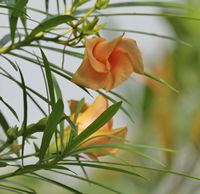
Plenty of other plants were imported into Ghana and other tropical countries – the edible ones include tomatoes, chilis, cassava and maize from South America, and aubergines from Asia. It amazes me that these crops were so recently introduced. For us Europeans, how did we manage without tomatoes? And for Ghanaians, how did they spice up the sauce that flavoured their yams?
There are many exotic ornamental plants that decorate the streets and gardens of Ghana. Two South American families have been really successful – Apocynaceae and Bignoniaceae. I grew up with sublimely scented frangipanis (Plumeria sp. top photo by Renesis) in our garden, and hedges of yellow oleander 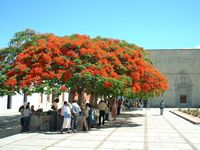
Walking round the major towns – Cape Coast and Accra – you'll encounter the usual suspects in amenity plantings. Plenty of scarlet Hibiscus; Acacia; Bougainvillea and flamboyant (Delonix regia - lower photo by Stephen Lea). Two trees that thrive here are the Norfolk Island Pine (Araucaria heterophylla - I had no idea it was related to the Monkey Puzzle; just loved it at Manly, north of Sydney) and a fastigiate version of the Persian lilac (Melia azedarach), which works well as a columnar street tree.
Margaret Waddy
SCI Horticulture Group
Fruit Focus
Farm tours are always popular with visitors at Fruit Focus at East Malling Research. This year, amongst other research projects, a five-year HortLink project (HL0191) on minimising pesticide residues in strawberry through integrated pest, disease and environmental crop management was on show. Professor Jerry Cross, who leads the team, and Michelle Fountain were able to tell growers that excellent progress has been made with some important findings and implications for pest and disease management in strawberry.
The overall aim of the project is to develop alternative, sustainable, non-pesticidal methods for managing Botrytis, powdery mildew, black spot, aphids, blossom weevil and capsid bugs on strawberries so greatly reducing (by >50%) pesticide use and eliminating the occurrence of reportable pesticide residues in harvested fruit.
The project has shown, for instance, that infection of fruit and flowers by Botrytis on June-bearer crops covered early in the season is minimal suggesting that Botrytis fungicides may not be necessary in this situation. Where treatment does become necessary, researchers have shown that honey and bumble bees can effectively carry a specially formulated Botrytis biocontrol product to strawberry flowers. This may provide an efficient way of treating crops.

A 'supertrap' for strawberry blossom weevil has been developed which combines the weevil's sex aggregation pheromone, a volatile from wild strawberry flowers, a white visual colour and a robust and effective trap design. These 'supertraps' are currently being evaluated for monitoring the weevil and control by mass trapping.
Fruit Focus has always been the ideal event for growers looking to discover new innovations and initiatives to enable them to be more productive and profitable. On the Agrovista stand, growers could see their new Fruitwise HyGro vertical growing system which effectively utilises the vertical space in the growing area to increase plant density and production whilst being environmentally kind. This is a key benefit allowing growers to optimise land use with fewer tunnels needed to grow the same amount of crop. Fewer tunnels will cause less planning headaches but are also a way of continuing to use tunnels on an approved site where the soil needs sterilising to continue cropping but finding new land to put up 'temporary tunnels' may be increasingly difficult.
The Fruitwise HyGro vertical growing system consists of columns of coir based, wagon-wheel shaped planting cells. The perforated central column is made up of injection-moulded segments that lock together. As the cells are independently irrigated and drained there is no chance of transmission of water borne disease. The system can be managed for run-off to waste or for recirculation unlike table tops where run-off from each bag drains to waste on the tunnel floor. It offers significant water saving (as little as four times less water than peat bags – on average 50 to 60ml per day per plant). Agrovista have trials of the Fruitwise system at several large UK strawberry growers and there is considerable interest and more development work going on in Holland and Germany.
Working demos, new machinery and growing technology were prevalent at this year's Fruit Focus Show. Machinery demonstrations proved popular again. Soft and top fruit growers, as well as vineyard owners needing a compact but heavy-duty tractor, were shown a new version of the Rex model launched by Landini at the show. A tighter-steering front drive axle for the Rex 'F' further improves the tractor's agility.
This year those looking to make green advances were also catered for thanks to the appearance of bpi.recycled products. Together, the two divisions of British Polythene Industries (BPI) plc promoted their ability to help growers operate in a more eco-sensitive way by keeping reusable polythene in circulation - and out of landfill. Currently, bpi.recycled products which ranks as Europe's largest recycler of waste polythene, reprocesses over 70,000 tonnes of waste polythene each year, including scrap from unwanted polytunnels and crop covers. The waste is used to create outdoor furniture, building supplies, refuse sacks and many other products.
Joanna Wood
SCI Horticulture Group
Plants of the Month
The Clock Vine - Thunbergia mysorensis, Acanthaceae
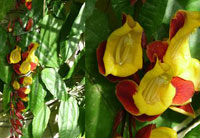
Medicinal Plant of the Month
Thorn Apple, Datura stramonium, Solanaceae
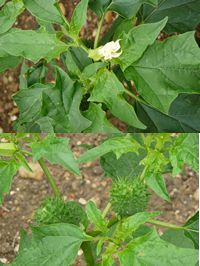
This plant has been used for many and various medicinal purposes including the treatment of mania, epilepsy and melancholy. It was also sold as a component of herbal cigarettes which were marketed as an asthma relief treatment. There may have actually been some basis in this since the molecules hyoscine and atropine both have relevant biological activity. The asthma drug ipratropium is a structural analogue based on these molecules and is effective when administered by inhalation.
There are also many interesting legends associated with this plant - if you want to find out more come along to the Horticulture Group AGM on 24 September!

Horticulture Industry News
A new source for pectin
For commercial use pectin is usually derived from waste material in citrus processing and cider making. Now pectin extracted from sugar beet pulp is attracting more and more interest because it has unusual emulsifying properties. New work from the Institute of Food Research has shown how sugar beet pectin acts as an efficient emulsifier, using a technique that could be used to unravel in the finest detail how such important food ingredients work. More
New monitoring traps
Vitax has launched a new range of apple maggot and plum maggot moth monitoring traps. They can be used to alert growers so that pesticides can be used to treat the pests. More
Broccoli by injection!
Sulforaphane , a chemical found in broccoli may help in the prevention and treatment of breast cancer. Scientists at the University of Michigan Comprehensive Cancer Centre carried out lab tests on mice and cell cultures with the disease. Those injected with sulforaphane showed a marked drop in the cancer stem cell population (Horticulture Week, 28 May 2010)
Topsoil - the essential guide

Strawberry Finesse
A new everbearing strawberry called 'Finesse' is now on the shelves at Sainsbury's and Tesco. An East Malling Research variety, 'Finesse' produces high yields and the heart-shaped berries are of 'excellent eating quality.' It has no runners and the fruit is well displayed for picking. There are no proprietary rights attached to this variety so it is available to all growers. (South East Farmer, July 2010).
Grants for HortiFair Exhibitors
The Commercial Horticultural Association (CHA) will be leading the UK participation to International HortiFair at Amsterdam RAI in the Netherlands 12-15 October 2010. There are a limited number of UK Trade and Investment TAP grants for eligible companies at this year's event. HortiFair has strengthened ties with the FloraHolland Trade Fair Aaslmeer to create a combined approach under the title 'Holland HortiWeek'. The two organisations will collaborate in organising their trade shows during the same week in November from 2011.
Reading and East Malling get closer
The University of Reading and East Malling Research in Kent have signed an important Memorandum of Understanding (MoU) as part of their ongoing commitment to further learning and knowledge in this area. The MoU was signed by Professor Gordon Marshall, Vice Chancellor of the University of Reading, and Dr Mike Solomon, Chief Executive of East Malling Research, at a ceremony at the University. The newly-forged relationship opens the door for the development of joint research programmes exploiting the strengths of both organisations. This will include joint bids for funding for research and knowledge transfer, a closer involvement of East Malling Research in the University's research on the National Fruit Collection at Brogdale, and the training of the next generation of crop scientists. The MoU will help ensure that research in horticultural crop science is economically sustainable and supported adequately by industry. The agreement also outlines how the two institutions will tackle the issues of academic standards and quality. (see: Co-operation is root to scientific success)
Pink is sweet
A pinkish gooseberry is being renamed as faeberry with the description that it is much sweeter than culinary types. Young bunched carrots at Tesco have been branded 'Bushy Tops'. (Fresh Produce Journal, 16 July).
New Institute, New Director

Professor Iain Gordon, who holds both British and Australian nationality currently leads biodiversity research teams across various centres for the Commonwealth Scientific and Industrial Research Organisation in Canberra. More
Growers pay for cheap food….
Food Justice: the report of the Food and Fairness Inquiry, has been published today and finds that farmers, agricultural workers, the environment and consumers are paying a high price for the food we eat. The inquiry committee of 14 came from a broad range of organisations across the food sector and included representation from the NFU.
…Hope may be at hand
An adjudicator to resolve disputes between supermarkets and their suppliers is to be established under plans announced by the government. The Groceries Code Adjudicator (GCA) will sit within the Office of Fair Trading (OFT), but will be independent, the government said. It will investigate complaints from UK and overseas suppliers about the way they are treated by supermarkets. More
Agri-Food Hub
SCI Technical Interest Groups which cover the science and business of food production 'from plough to plate,' are now linked closer than ever before with the launch of the Agri-Food Hub. The aim is to release the huge potential for collaboration between the Groups involved – initially BioResources, Environment, Horticulture and the two Food Groups. Issues around food and the way in which it is produced, processed and sold are never far away, so forging stronger links between these groups and networks makes good sense.
Longhorn beetles found in UK
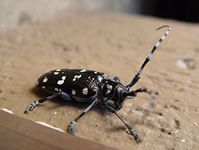
Citrus longhorn beetle is a non-native pest that can be extremely damaging to a wide range of broadleaved trees and shrubs posing a serious threat to horticulture, forestry and native trees in the UK. The beetle is not normally present in the UK, but there have been isolated findings associated with imported trees and shrubs (principally Japanese maple - Acer palmatum). (NFU Horticulture and Potato News 3 August 2010) More
Quotes of the Month
'It's frustrating when you know all the answers but nobody bothers to ask you the questions'.
Anon
eEvents Calendar
Other Events of Interest
International Workshop on Fire Blight
16 - 20 Aug 2010, International Society for Horticultural Science
Warsaw, Poland
International Horticultural Congress
22 - 27 Aug 2010, International Society for Horticultural Science
Lisbon, Portugal
Plantarium
25 - 28 Aug 2010
Boskoop, the Netherlands
International Symposium on the Genus Lilium
30 Aug 2010 - 3 Sep 2010, International Society for Horticultural Science
Pescia, Tuscany, Italy
International Advances in Plant Virology
5 - 7 Sep 2010, Association of Applied Biologists
Arnhem, the Netherlands
Spoga
5 - 7 Sep 2010, Koelnmesse
Cologne, Germany
Four Oaks Trade Show
7 - 8 Sep 2010
Lower Withington, Cheshire, UK
Delivering Food Security with Supply Chain Led Innovations
7 - 9 Sep 2010, Association of Applied Biologists
Egham, Surrey
Saltex
7 - 9 Sep 2010, Institute Of Groundsmanship
Windsor, UK
Abbotsbury Tropical Gardens and Michaud's Chili, Sweet Pepper etc.
8 Sep 2010, Professional Horticulture Group South West
West Bexington, Dorset, UK
Food Security and Safety Symposium
13 - 15 Sep 2010, Society for Experimental Biology
Lancaster University, UK
Green Roofs For A Changing Climate
15 - 16 Sep 2010, London, UK
GLEE
20 - 22 Sep 2010
NEC Birmingham, UK
Peat in Horticulture
11 Oct 2010, International Society for Horticultural Science
Amsterdam, The Netherlands
International Conference on Organic Greenhouse Horticulture
11 -14 Oct 2010, International Society for Horticultural Science
Bleiswijk, The Netherlands
HortiFair
12 -15 Oct 2010
RAI, Amsterdam, the Netherlands
World Emulsions Congress
12 - 14 Oct 2010
Lyon, France
Cactus Pear and Cochineal
17 Oct 2010, International Society for Horticultural Science
Agadir, Morocco
National Fruit Show
20 - 21 Oct 2010, Marden Fruit Show Society
Detling, Kent UK
Workshop on Biological Control of Postharvest Diseases
25 - 28 Oct 2010, International Society for Horticultural Science
Leesburg, Virginia, USA
Crop World
1 - 3 Nov 2010, United Business Media and British Crop Protection Council
ExCel, London UK
Predicting and Controlling the Shelf-Life of Foods
3 - 4 Nov 2010, Food Chain CIC
Leatherhead, Surrey, UK
Know Your Plants - Developing skills for better science, horticulture and communication
3 - 5 Nov 2010, Botanic Gardens Education Network
Royal Botanic Gardens, Edinburgh, UK
Advances in Biological Control
17 Nov 2010, Association of Applied Biologists
Marston, Lincs, UK
Towards 2013. An agriculture fit for purpose
17 - 18 Nov 2010, British Institute of Agricultural Consultants
Wellesbourne, Warwick, UK
Bananas, Genetics and Appropriate Biotechnology
18 Nov 2010, Society of Biology
Nottingham, UK
Tropical Horticulture
22 - 26 Nov 2010, International Society for Horticultural Science
Kingston, Jamaica
Oatridge Conference and Exhibition
25 Nov 2010, Scotgrow
Ecclesmachan, Nr Edinburgh, UK
Innovative ideas in pest and weed control in field vegetables
25 Nov 2010, Association of Applied Biologists
Rothamsted Research, Harpenden, UK
What makes an alien invasive?
7 - 8 Nov 2010, Association of Applied Biologists
Edinburgh, UK
Water and nitrogen use efficiency in plants and crops
15 -16 Dec 2010, Association of Applied Biologists
Grantham, UK
Stress Responses – molecules, organisms, environments
4 - 7 Jan 2011, British Ecological Society, Society for Experimental Biology, Biochemical Society
London, UK
- If you would like to advertise a forthcoming event please contact communications@soci.org.
Horticulture Group Contact Details
For submitting ideas or to volunteer to be part of a committee or a group, please contact:
Acting Chairman - Peter Grimbly
Meetings Secretary - Marion Stainton
Minutes Secretary - Margaret Waddy
Newsletter co-ordinator - Sue Grimbly, E: scihortigroup@btinternet.com
SCI contact - communications@soci.org T: +44(0)20 7598 1500
